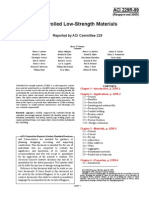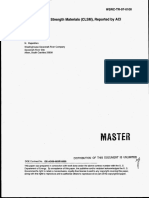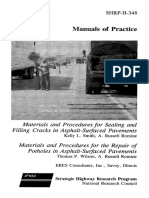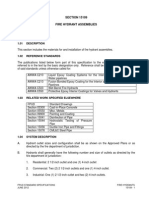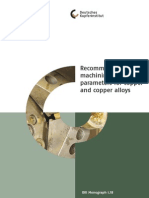CLSM - Australia
Uploaded by
N GANESAMOORTHYCLSM - Australia
Uploaded by
N GANESAMOORTHYDatasheet > apr
2008
CONTROLLED Low-strength
Material
Introduction From the above description, it can be seen
Controlled Low-Strength Material (clsm) is a that CLSM is a cementitious material which can
cementitious fill that is in a flowable state at the be mixed, transported and delivered using normal
time of placement and has limited compressive ready-mix operation techniques and processes. The
>
strength to facilitate subsequent excavation. material does not look like concrete but it performs
CLSM is also known as flow-crete and controlled in a similar manner since it has cementitious
density fill as well as by various proprietary names. properties and, with time, will become quite hard.
The material has gained appreciable recognition The latter must be controlled so that it does not
in the USA and Canada as a fill material because become too hard.
of its inherent advantages. These include flowing As with any concrete, strength is influenced by
placement without segregation, self-consolidation, the quantity of water and cement. Very high water
controlled density, controlled strength, ease of content (300 to 450 kg/m3) and very low cement
excavation, and economy. content (25 to 100 kg/m3) are quite normal for
Development of CLSM has centred around CLSM. Fly ash, sand and, in some cases, coarse
mixtures using a sand filler. The inter-particle voids aggregates, are selected for their ability to flow
are slightly over-filled with a fluid paste composed rather than for their contribution to strength
of cement and water, with the possible addition properties. This implies that sand not suitable for
of fly ash. Components of the paste are varied in regular concrete may perform quite well in CLSM.
quantity to achieve the required performance in Indeed, sands with as much as 30% fines have
terms of strength development, self-consolidation, proven satisfactory.
flow behaviour characteristics, durability, economy
>
and ease of removal.
Overseas experience has shown the sand filler
mixtures to have performed well, giving all the
properties desired. It may be difficult to achieve
satisfactory flowability and there may be severe Controlled Low-Strength
bleeding in cement-sand slurries although fly
ash can be of assistance in obtaining properties of Material is a cementitious fill
flowability with reduced bleeding.
that is in a flowable state at the
time of placement
Control of the material on site is best achieved TABLE 1
by a flow test. A cylinder or cone is placed on a flat
hard surface and filled with the flowable mix. When Use/application Criteria
the mould is lifted, the material will spread on the
flat surface. If the measured spread of the CLSM General purpose Easy excavation required.
reaches the predetermined distance, the mix is backfill Early strength not critical.
considered to have acceptable flow. High degree of flowability.
28-day strength 0.5 MPa.
Applications
CLSM is ideal for use in any backfilling operation Roadway trench High early bearing strength
where it is important to minimise settlement or backfill required.
where there is restricted access for compaction Good flowability.
equipment. It is also advantageous for backfilling 28-day strength 1.5 to 2 MPa.
excavations in soils that are prone to collapse when
normal compaction equipment is used. Structural Good flowability.
Typical applications are: backfill 28-day strength to engineering
n backfilling utility trenches; requirements.
n filling abandoned underground structures,
egtanks, sewers, tunnels, etc;
n backfilling bridge abutments and retaining walls; Mixing and Placing
n most situations where soil backfill is required. CLSM is best batched and mixed using equipment
normally used to mix concrete. It is generally
Where backfill may have to be excavated at a placed direct from agitator trucks but can be placed
later date, the strength of CLSM must be limited. using chutes, skips or pumps. Where the material
Strengths up to 2 MPa at 28 days can generally be is to be pumped, higher cementitious contents may
excavated using normal construction equipment. be required. This in turn will result in increased
As CLSM is a highly fluid material, consideration strength which may be undesirable if backfill
must be given to the lateral pressure exerted during material is likely to be excavated at a later date.
placement; lightweight pipes, etc may need to be
anchored to prevent flotation. Trench Backfill
The backfilling of service trenches is an obvious
Mixes application for CLSM, particularly under paved
CLSM mixes should be designed for the particular areas where its hardened state non-settlement
flowing characteristics required as well as the properties minimise trench subsidence and hence
compressive strength necessary. long-term maintenance costs.
As indicated previously aggregates are chosen As CLSM does not have to be compacted, the
more for their compatibility with the CLSMs flowing width of the trench is not determined by compaction
characteristics than their contribution to strength. techniques as with conventional backfill; trenches
A wide range of fine aggregates including can therefore often be much narrower, ie just wider
sands, gravels and quarry waste material can than the service to be installed.
be used to produce satisfactory CLSM mixes. It No compaction and little, or no, spreading is
is not necessary for aggregate to comply with required. When filling long trenches, moving the
AS2758.11985. Aggregates should, however, be discharge point along the trench helps spread the
free of reactive or expansive materials. Coarse material. The surface may require some minor
aggregates are not normally included in CLSM. levelling with a shovel. The trench should be filled
Types GB or GP cement in accordance with to slightly above the bottom of the pavement. This
AS3972 can be used in the production of CLSM. allows for bleed water in the mix, which will rise
Where fly ash is used to improve flowability it should to the surface, and for some plastic settlements to
be noted that early strengths will be reduced. occur.
A maximum 28-day strength of 0.5 MPa is If it is not practical to place the pavement
suggested where future hand excavation is likely immediately, the trench is filled flush with the
and 1.52 MPa for mechanical excavation. pavement surface and the CLSM temporarily
Slumps that will suit most applications of CLSM are used as a wearing surface. The CLSM can be later
around 200 mm. Suggested criteria for CLSM mixes removed to the required depth and the pavement
are given in Table 1. material placed.
Where it is necessary to carry out pavement
restoration within 24 hours, mixes giving 28-day
strengths of at least 1.5 MPa to 2 MPa should be
used. CLSM backfill should be protected from any
foot or vehicular traffic until it has hardened.
Page 2 of 3 > CONTROLLED Low-strength Material
apr Structural Backfill
CCAA OFFICES
SYDNEY OFFICE:
2008 Where CLSM is used as a structural backfill or
subbase, compressive strengths greater than
Level 6, 504 Pacific Highway
St Leonards NSW Australia 2065
POSTAL ADDRESS:
2MPa may be required depending on engineering Locked Bag 2010
design requirements. St Leonards NSW 1590
TELEPHONE: (61 2) 9437 9711
FACSIMILE: (61 2) 9437 9470
Bibliography BRISBANE OFFICE:
n Matthews, SC, Controlled Low Strength Level 14, IBM Building
Material for Excavation Backfill in Roads, 348 Edward Street
Brisbane QLD 4000
Proceedings 16th ARRB Conference, Part 3, TELEPHONE: (61 7) 3831 3288
pp109122, 1992. FACSIMILE: (61 7) 3839 6005
n Unshrinkable Fill for Utility Trenches in MELBOURNE OFFICE:
Streets, CP004.02P, Canadian Portland Cement 2nd Floor, 1 Hobson Street
South Yarra VIC 3141
Association, 1990. TELEPHONE: (61 3) 9825 0200
n ACI Committee 229, Controlled Low-Strength FACSIMILE: (61 3) 9825 0222
Materials, ACI Manual of Concrete Practice, PERTH OFFICE:
Part 2, pp 229R-1-229R-15, 2008. 45 Ventnor Avenue
West Perth WA 6005
TELEPHONE: (61 8) 9389 4452
FACSIMILE: (61 8) 9389 4451
> Further information on good concreting ADELAIDE OFFICE:
practices can be downloaded from the Cement Greenhill Executive Suites
213 Greenhill Road
Concrete and Aggregates Australia website at Eastwood SA 5063
www.concrete.net.au. POSTAL ADDRESS:
PO Box 229
Fullarton SA 5063
TELEPHONE: (61 8) 8274 3758
FACSIMILE: (61 8) 8373 7210
EXTRACTIVE INDUSTRIES OFFICE
PO Box 243
Henley Beach SA 5022
TELEPHONE: (61 8) 8243 2505
FACSIMILE: (61 8) 8125 5822
TASMANIAN OFFICE:
EXTRACTIVE INDUSTRIES OFFICE
PO Box 246
Sheffield TAS 7306
TELEPHONE: (61 3) 6491 2529
FACSIMILE: (61 3) 6491 2529
WEBSITE: www.concrete.net.au
EMAIL: info@ccaa.com.au
DESIGN: Helen Rix Design
Disclaimer: Cement Concrete & Aggregates
Australia is a not for profit organisation sponsored
by the cement concrete and aggregate industries
in Australia to provide information on the many
uses of cement, concrete and aggregates. This
publication is produced by CCAA for that purpose.
Since the information provided is intended for
general guidance only and in no way replaces the
services of professional consultants on particular
projects, no legal liability can be accepted by
CCAA for its use.
CCAA respects your privacy. Your details have
been collected to provide you with information on
our activities, publications and services. From time
to time your details may be made available to third
party organisations who comply with the Privacy
Act such as affiliated associations, sponsors of
events and other reputable organisations whose
services we think you may find of interest. If you
do not wish to receive information from CCAA or
wish to be taken off the database please write to
the Privacy Officer, CCAA, Locked Bag 2010,
St Leonards, NSW, 1590
Page 3 of 3 > CONTROLLED Low-strength Material
You might also like
- Nature, Elements and Dance AppreciationNo ratings yetNature, Elements and Dance Appreciation76 pages
- Controlled Low Strength Materials (CLSM) : Reported by ACI Committee 229No ratings yetControlled Low Strength Materials (CLSM) : Reported by ACI Committee 22913 pages
- Guide Specification For Controlled Low Strength Materials (CLSM)No ratings yetGuide Specification For Controlled Low Strength Materials (CLSM)15 pages
- IJCE - Utilization of Sludge, Recycled Coarse Aggregates in Production of Controlled LowStrength Materials A ReviewNo ratings yetIJCE - Utilization of Sludge, Recycled Coarse Aggregates in Production of Controlled LowStrength Materials A Review12 pages
- Construction and Building Materials: Vahid Alizadeh, Sam Helwany, Al Ghorbanpoor, Konstantin SobolevNo ratings yetConstruction and Building Materials: Vahid Alizadeh, Sam Helwany, Al Ghorbanpoor, Konstantin Sobolev7 pages
- Controlled Low Strength Material June 2021No ratings yetControlled Low Strength Material June 202164 pages
- Final Draft Summary Controlled Low Strength MaterialsNo ratings yetFinal Draft Summary Controlled Low Strength Materials7 pages
- Effect of Paste Volume On Performance of Controlled Low Strength MaterialsNo ratings yetEffect of Paste Volume On Performance of Controlled Low Strength Materials8 pages
- NDRM CPA Spring Concrete Workshop CLSM Mar 2012 PDFNo ratings yetNDRM CPA Spring Concrete Workshop CLSM Mar 2012 PDF39 pages
- Sustainable Development Using Controlled Low-Strength MaterialNo ratings yetSustainable Development Using Controlled Low-Strength Material20 pages
- A Comprehensive Study On Controlled Low Strength Material-2023No ratings yetA Comprehensive Study On Controlled Low Strength Material-202339 pages
- Stress-Strain Behaviour of Flowable FillNo ratings yetStress-Strain Behaviour of Flowable Fill14 pages
- Controlled Low Strength Material (CLSM) : Information Bulletin / Public - Building Code P/BC 2011-121No ratings yetControlled Low Strength Material (CLSM) : Information Bulletin / Public - Building Code P/BC 2011-1213 pages
- Use of Controlled Low-Strength Material (CLSM) As Controlled FillNo ratings yetUse of Controlled Low-Strength Material (CLSM) As Controlled Fill2 pages
- Special Construction Methods: Harza Engineering CompanyNo ratings yetSpecial Construction Methods: Harza Engineering Company48 pages
- Controlled Low Strength Material (CLSM)No ratings yetControlled Low Strength Material (CLSM)11 pages
- Controlled low strength material - WikipediaNo ratings yetControlled low strength material - Wikipedia1 page
- CMP Detention and Infiltration Installation Guide: Engineered SolutionsNo ratings yetCMP Detention and Infiltration Installation Guide: Engineered Solutions4 pages
- Master Specification - Part Rd-Ew-C4 - Controlled Low Strength MaterialNo ratings yetMaster Specification - Part Rd-Ew-C4 - Controlled Low Strength Material5 pages
- Controlled Low Strength Material (CLSM) Produced FromNo ratings yetControlled Low Strength Material (CLSM) Produced From177 pages
- 777-JBMS-Original Article-1819-1-10-20201207No ratings yet777-JBMS-Original Article-1819-1-10-2020120715 pages
- Evaluation of Self Compacting Concrete With Partial Replacement of Recycled AggregatesNo ratings yetEvaluation of Self Compacting Concrete With Partial Replacement of Recycled Aggregates7 pages
- Grice 1998 - Underground Mining With BackNo ratings yetGrice 1998 - Underground Mining With Back7 pages
- Underground Mining With Backfill: by A GriceNo ratings yetUnderground Mining With Backfill: by A Grice6 pages
- Self Compacting Concrete & Pre Placed Concrete100% (2)Self Compacting Concrete & Pre Placed Concrete33 pages
- Use of Brick Dust, Fly Ash and Cement Kiln Dust As A Replacement of Fine Aggregate in Self Compacting ConcreteNo ratings yetUse of Brick Dust, Fly Ash and Cement Kiln Dust As A Replacement of Fine Aggregate in Self Compacting Concrete7 pages
- Chapter 4. Concrete Materials and Properties: Soils, Subgrade, and SubbaseNo ratings yetChapter 4. Concrete Materials and Properties: Soils, Subgrade, and Subbase13 pages
- Chapter-1: 1.1 GENERAL:-Concrete Is One of The Foremost Versatile Building Materials. It Will Be Cast ToNo ratings yetChapter-1: 1.1 GENERAL:-Concrete Is One of The Foremost Versatile Building Materials. It Will Be Cast To51 pages
- Evaluating The Use of SS and CW in AsphaNo ratings yetEvaluating The Use of SS and CW in Aspha5 pages
- BSI Training Academy: Flexible Learning. Trusted ExpertiseNo ratings yetBSI Training Academy: Flexible Learning. Trusted Expertise5 pages
- Ford Ecosport Vs Honda WR-V Comparison - Prices, Specs, FeaturesNo ratings yetFord Ecosport Vs Honda WR-V Comparison - Prices, Specs, Features22 pages
- Is 1199 (1959) - Methods of Sampling and Analysis of ConcreteNo ratings yetIs 1199 (1959) - Methods of Sampling and Analysis of Concrete49 pages
- Is 14268 (1995) - Uncoated Stress Relieved Low Relaxation Seven-Ply Strand For Prestressed ConcreteNo ratings yetIs 14268 (1995) - Uncoated Stress Relieved Low Relaxation Seven-Ply Strand For Prestressed Concrete12 pages
- Is 15388 (2003) - Specification For Silica FumeNo ratings yetIs 15388 (2003) - Specification For Silica Fume13 pages
- Asphalt Pavement Repair Manuals of PracticeNo ratings yetAsphalt Pavement Repair Manuals of Practice173 pages
- Abeco Tanks (Pty) LTD: Manufactured in South Africa100% (1)Abeco Tanks (Pty) LTD: Manufactured in South Africa12 pages
- Salamair To Add Six New A320Neo To Its Growing Fleet100% (1)Salamair To Add Six New A320Neo To Its Growing Fleet1 page
- Raw vs. Part Heat Treatments - What Is The Difference.No ratings yetRaw vs. Part Heat Treatments - What Is The Difference.4 pages







